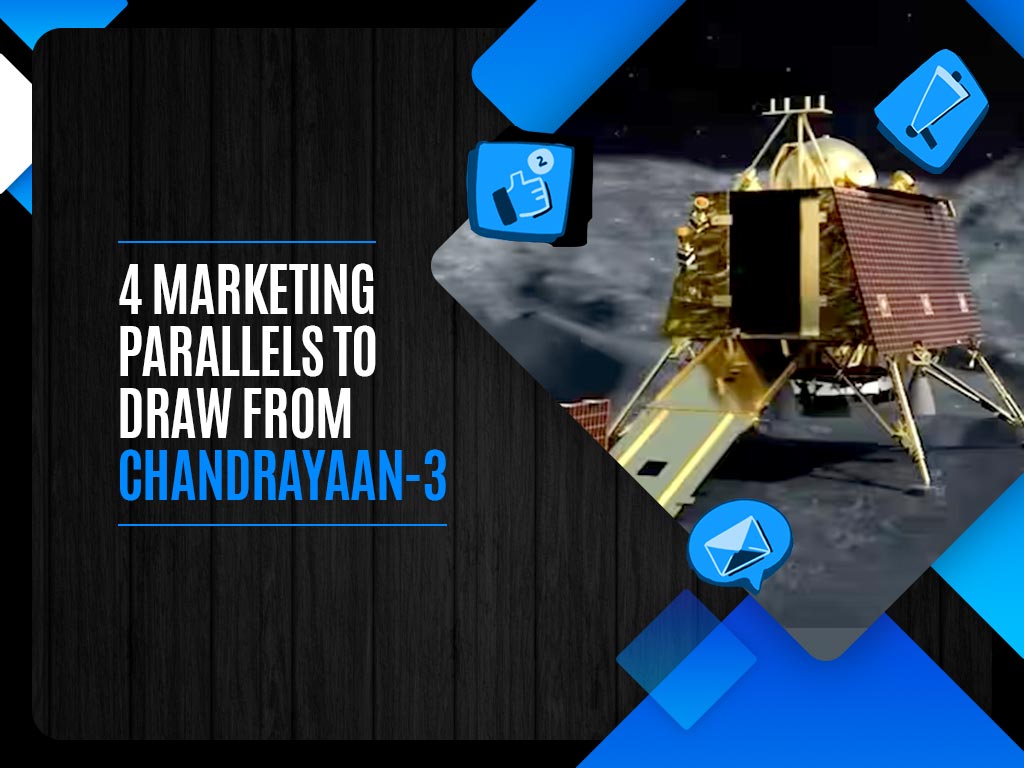4 Marketing Parallels to draw from Chandrayaan- 3

India’s recent mission to moon namely the Chandrayaan 3 has successfully landed on the South Pole, making India the first country to venture into the South Pole of the lunar surface and only the fourth country ever to land successfully on the Moon. Under the able guidance of Indian Space Research Organization (ISRO), Chandrayaan-3 is a follow up of Chandrayaan-2 and consists of Vikram lander and Pragyan rover.
But what has marketers got to do with all this Rocket Science? Well, a lot, to be honest. But only if you have a discerning eye for inspiration. In this blog post, we will look at what 5 different learnings every marketer can draw from the Chandrayaan-3 mission.
1. First thing First. Start with a specific & simple goal:
Chandrayaan-3 mission started with a simple objective. The Chandrayaan-3 mission aimed at getting a lander to land safely on the lunar surface, observe the driving capability of the rover and conduct basic experiments to understand the composition of Moon.
This meant that every tech on the lander and the rover are curated accordingly. The dimensions were mobile. And it removed all those unnecessary attachments, making the entire propulsion model compact and to the point. Adding more to the mission objectives would only mean more complexities, technicalities, more weight to the payload, and more points of failure.
Likewise, a simple and specific marketing goal will help you identify the right audience. You will be able to identify effective communication channels, efficient resource allocation, measurable progress, and reduced confusion. This will help you to achieve the goals you have set for your marketing campaigns.
2. Secondly, never be afraid of failures:
Chandrayaan-3 is a follow-up on Chandrayaan-2. ISRO on its previous attempt failed to land successfully as it deviated from the trajectory. The lander was off by 600 kilometers from its intended landing spot. Shortly after the landing, the lander lost all connections on touchdown because of a failure glitch.
Chandrayaan-3 learned from its predecessor and was equipped with more fuel, better guidance, navigation, and control system to correct major deviations. All in all, a total of 21 subsystem improvements were made to Chandrayaan-3.
Likewise, your marketing campaigns might fall mid-way through. Maybe it was poor targeting, lack of Ideal Customer Profiles, ineffective content, or inadequate research that contribute to failure of a campaign. The key is you do not repeat the mistakes and that you learn from them. Analyze where your campaign failed!
Was it a weak value proposition or incorrect timing in reaching out to your leads? Identify what was the root cause problem. And then work on it. Maybe create triggers and automate sending out personalized messages to your leads so that you do not mistime your outreach program.
6 best Marketing & Advertising Campaigns for B2B Business: Read now
3. Unique Selling Proposition:
Since the 60s, several space agencies have landed on the Moon on numerous occasions. The Apollo program was the first manned mission. Whereas, the Luna program became the first soft landing mission. Chang’e Program saw the first retrieval of lunar sample. Consequently, many argue that there is nothing new in a mission to the moon.
However, Chandrayaan-3 found a unique selling proposition for its Moon landing. India has become the first country to land and venture into the South Pole of the lunar surface. But why is it so significant? Because that is where existence of lunar water is probable. This means that the Artemis mission and developing a station on the moon will significantly depend on the findings of the Chandrayaan-3 mission.
Likewise, your marketing campaigns should offer something new and unique to the market. This requires identifying the gaps among your competitors. And then converting that gap into opportunity. Do not offer something unique just for the sake of standing out. Your USP must be relatable, and it should address the challenges the market is facing.
4. Cost effectiveness: Achieving more with less:
Probably, the major claim to fame for the Chandrayaan-3 mission to moon is its cost effectiveness. Russia spent $200 million on Luna; NASA spent $355 million on Apollo 11. Chandrayaan-3 on the other hand spent merely $75 million to achieve its MO. This can have a huge effect on future space missions as cost is a big deterrent. Making space missions affordable without compromising on your tech and scientific propositions is a feat in itself. Chandrayaan-3 is the epitome of effective use of resources and making things work at a reduced cost.
Likewise, your marketing campaigns need not be heavily funded. Extracting maximum output from minimum investment is how you as a marketer can add value to your company, and offer services or products that are affordable and popular among your audience. Your marketing efforts and campaigns won’t be sustainable in the long run if you are spending a huge portion of your budget.
Shooting for the moon:
As I wrap up this analogy, keep in mind that, much like Chandrayaan-3, your marketing endeavors are primed for greatness. Strive for ambitious goals, reach out for highest peaks, and push beyond the ordinary. Just as Chandrayaan-3 shattered all of our previous presumptions and unraveled a new era for space exploration, your marketing strategies have the power to propel your brand towards an extraordinary path of success.

